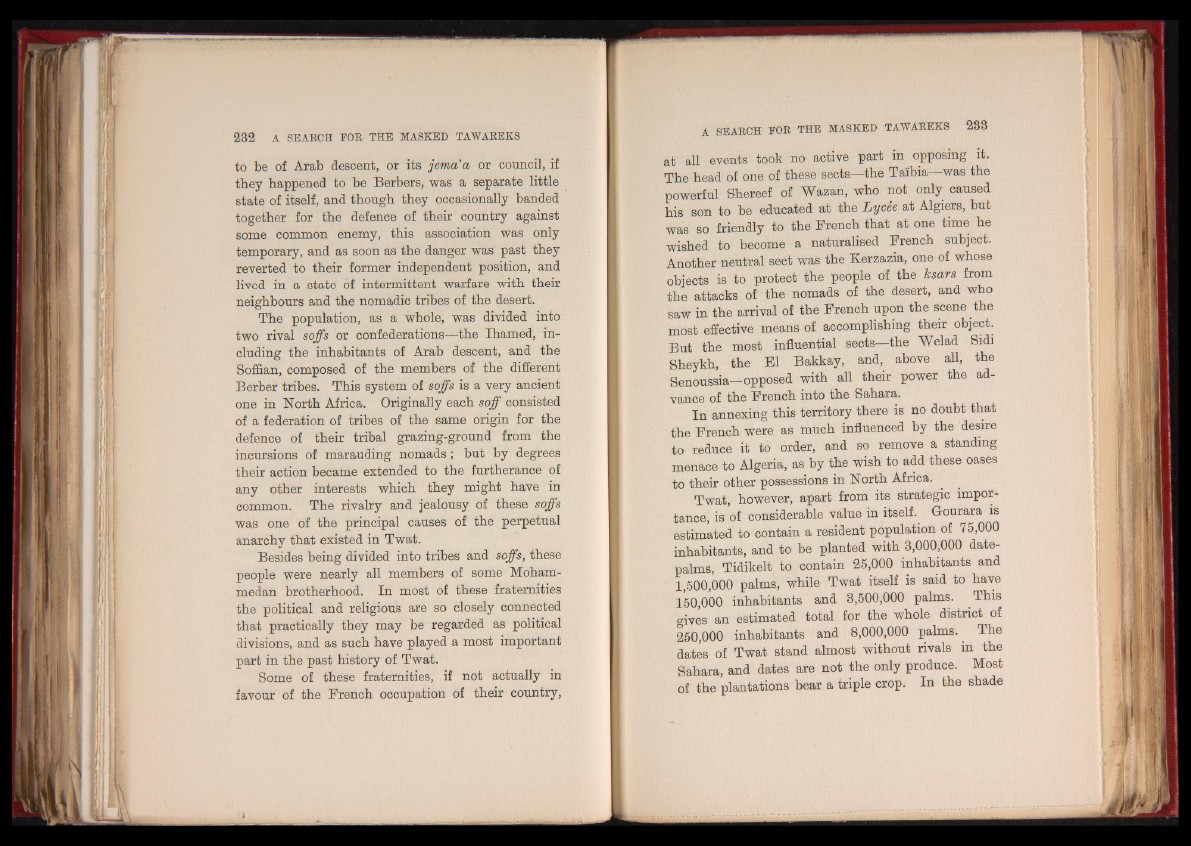
to be of Arab descent, or its jema’a or council, if
tbey happened to be Berbers, was a separate little
state of itself, and though they occasionally banded
together for the defence of their country against
some common enemy, this association was only
temporary, and as soon as the danger was past they
reverted to their former independent position, and
lived in a state of intermittent Warfare with their
neighbours and the nomadic tribes of the desert.
The population, as a whole, was divided into
two rival soffs or confederations—the Ihamed, including
the inhabitants of Arab descent, and the
Soffian, composed of the members of the different
Berber tribes. This system of soffs is a very ancient
one in North Africa. Originally each soff consisted
of a federation of tribes of the same origin for the
defence of their tribal grazing-ground from the
incursions of marauding nomads; but by degrees
their action became extended to the furtherance of
any other interests which they might have in
common. The rivalry and jealousy of these soffs
was one of the principal causes of the perpetual
anarchy that existed in Twat.
Besides being divided into tribes and soffs, these
people were nearly all members of some Mohammedan
brotherhood. In most of these fraternities
the political and religious are so closely connected
that practically they may be regarded as political
divisions, and as such have played a most important
part in the past history of Twat.
Some of these fraternities, if not actually in
favour of the French occupation of their country,
at all events took no active part in opposing it.
The head of one of these sects—the Taïbia was the
powerful Shereef of Wazan, who not only caused
his son to be educated at the Lycée at Algiers, but
was so friendly to the French that at one time he
wished to become a naturalised French subject.
Another neutral sect was the Kerzazia, one of whose
objects is to protect the people of the hsars from
the attacks of the nomads of the desert, and who
saw in the arrival of the French upon the scene the
most effective means of accomplishing their object.
But the most influential sects—the Welad Sidi
Sheykh, the El Bakkay, and, above all, the
Senoussia-opposed with all their power the advance
of the French into the Sahara,.
In annexing this territory there is no doubt that
the French were as much influenced by the desire
to reduce it to order, and so remove a standing
menace to Algeria, as by the wish to add these oases
to their other possessions in North Africa.
Twat, however, apart from its strategic importance,
is of considerable value in itself. Gourara is
estimated to contain a resident population of 75,000
inhabitants, and to be planted with 3,000,000 date-
palms, Tidikelt to contain 25,000 inhabitants and
1.500.000 palms, while Twat itself is said to have
150.000 inhabitants and 3,500,000 palms. This
gives an estimated total for the whole district of
250.000 inhabitants and 8,000,000 palms. The
dates of Twat stand almost without rivals in the
Sahara, and dates are not the only produce. Most
of the plantations bear a triple crop. In the shade